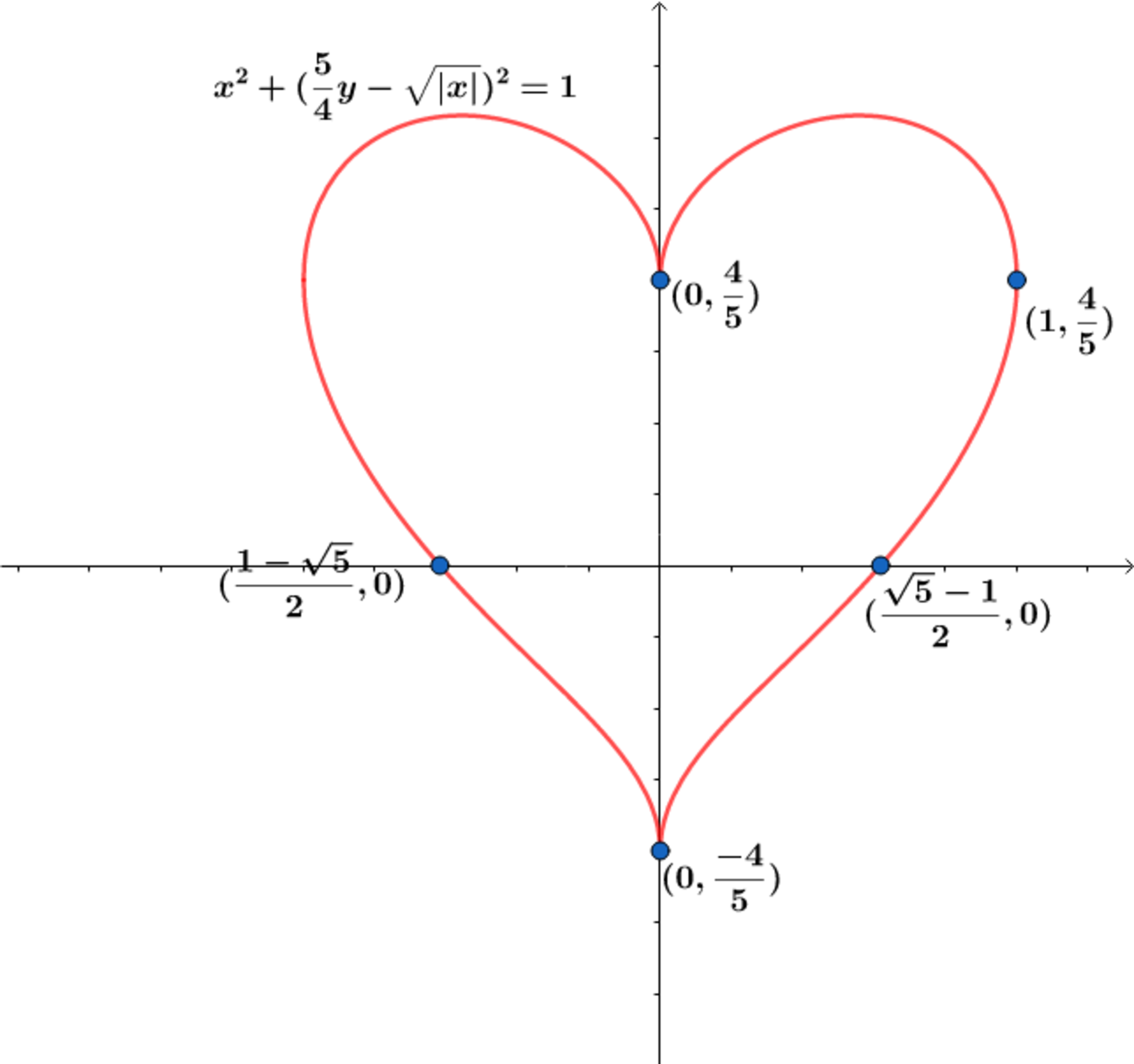Hearts And Conics.
Find the conic a x 2 + + b x y + c x 2 + d x + e y = − 1 , using the five points below, that intersects the curve x 2 + ( 4 5 y − ∣ x ∣ ) 2 = 1 .
Then, to six decimal places, find the area of the region bounded by the curve f ( x ) = 5 4 ( x − 1 − x 2 ) , the positive x -axis, the lines y = 5 4 and y = − 5 4 , and the conic.

The answer is 0.091559.
This section requires Javascript.
You are seeing this because something didn't load right. We suggest you, (a) try
refreshing the page, (b) enabling javascript if it is disabled on your browser and,
finally, (c)
loading the
non-javascript version of this page
. We're sorry about the hassle.
To show the conic is an ellipse.
Using the point ( 1 , 5 4 ) we obtain (1): a + 5 4 b + 2 5 1 6 c + d + 5 4 e = − 1
Using the point ( 0 , 5 4 ) we obtain (2): 2 5 1 6 c + 5 4 e = − 1
Using the point ( 0 , 5 − 4 ) we obtain (3): 2 5 1 6 c − 5 4 e = − 1
Using the point ( 2 5 − 1 , 0 ) we obtain (4): ( 2 5 − 1 ) 2 a + ( 2 5 − 1 ) d = − 1
Using the point ( 2 5 − 1 , 0 ) we obtain (4): ( 2 5 − 1 ) 2 a − ( 2 5 − 1 ) d = − 1
Using (4) and (5) we obtain: a = − ( 5 − 1 2 ) 2 and d = 0 .
Using (2) and (3) we obtain: c = 1 6 − 2 5 and e = 0 .
Using (1) ⟹ b = 4 5 ( 5 − 1 2 ) 2 .
Let x 0 = 2 5 − 1 ⟹ a = x 0 2 − 1 , b = 4 5 ( x 0 2 1 ) , c = 1 6 − 2 5 , and d = e = 0 ⟹ 1 6 x 2 − 2 0 x y + 2 5 x 0 2 y 2 = 1 6 x 0 2 and b 2 − 4 a c < 0 ⟹ we have an ellipse.
To find the area desired we need to solve for y = g ( x ) :
Solving for y we obtain y = 5 x 0 2 2 ( ± 4 x 0 4 − ( 4 x 0 2 − 1 ) x 2 + x ) .
We want the ellipse below the line y = 5 x 0 2 2 x which is g ( x ) = 5 x 0 2 2 ( − 4 x 0 4 − ( 4 x 0 2 − 1 ) x 2 + x )
Using the given f ( x ) = 5 4 ( x − 1 − x 2 ) ⟹
A 1 = ∫ x 0 1 g ( x ) − f ( x ) d x and A 2 = ∫ 0 x 0 f ( x ) − g ( x ) d x .
For A 1 :
Let A ∗ = ∫ x 0 1 5 x 0 2 2 ( − 4 x 0 4 − ( 4 x 0 2 − 1 ) x 2 + x ) d x
Let 4 x 0 2 − 1 x = 2 x 0 2 sin ( θ ) ⟹ d x = 4 x 0 2 − 1 2 x 0 2 d θ
⟹ A ∗ = 5 x 0 2 2 ( − 4 x 0 2 − 1 2 x 0 4 ∗ ( arcsin ( 2 x 0 2 4 x 0 2 − 1 x ) − 2 x 4 x 0 4 − ( 4 x 0 2 − 1 ) x 2 ) + 2 x 2 ) ∣ x 0 1 ≈ . 1 3 5 7 3 9 .
Let A ∗ ∗ = ∫ x 0 1 5 4 ( x − 1 − x 2 ) d x
Let x = sin ( θ ) ⟹ d x = cos ( θ ) d θ ⟹
A ∗ ∗ = 5 4 ( 4 π − 2 1 arcsin ( x 0 ) − 2 1 x 0 1 − x 0 2 + 3 2 x 0 2 3 − 3 2 ) ≈ − . 1 0 6 7 2 8 .
A 1 = A ∗ + A ∗ ∗ ≈ . 0 2 9 0 1 1
Similarly, for A 2 we obtain:
A 2 = 5 4 ( 3 2 x 0 2 3 − 2 1 arcsin ( x 0 ) − x 0 1 − x 0 2 ) ) + 5 4 x 0 2 − 1 4 x 0 2 arcsin ( 2 x 0 4 x 0 2 − 1 ) ≈ . 0 6 2 5 4 8
⟹ The desired area is A = A 1 + A 2 = 0 . 0 9 1 5 5 9 .